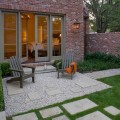Formal Gardening
Formal gardening is distinguished from other garden design styles by the sense that nature has been tamed for the purposes of serving the quality of human living. Order and symmetry are heavily emphasized through repeating patterns and mirrored elements. Regardless of the historical or cultural origin of a particular garden design, any formal style will share this intention and have certain clearly recognizable features in common with other styles.
Examples of such features include scenic vantage points, straight pathways and linear lines, low hedges, blocks of strong color, topiaries, clean geometric shapes, and at least one dividing axis. These features create designs that directly reflect or compliment the geometry of the house itself and that illustrate that nature itself can be transformed into a realm of human enjoyment and outdoor living space.
Even within a specific type of design, there are many formal gardening options that you can choose to personalize your particular garden. For instance, as a central focal point for your garden, you can choose to place a sculpture of some kind, a classical statue, a custom water fountain, or some type of reflecting pool. Seating can be created around such a focal point so as to turn this area into something of a courtyard that gives you a view of your home and the surrounding Houston landscape. If your garden is quite large, you can also have your landscaping company develop zones of interest in other places within it. Benches can be placed here as well as way stations for people traveling the walkways that bisect the garden hedges, trees, shrubs, and blocks of flowering plants. Decorative elements can be can also be intermingled with vegetation in these places so visitors can have a full sensory experience while they rest.
To achieve this near perfect use of geometry is no easy matter. This is why formal gardening is not a do-it-yourself project, and why it is best left to professional landscapers who know their botanical science and who can choose the very best plants on a highly selective basis. The biggest mistake people make when they attempt their own formal gardening is to overplant with too many species. This makes the garden look wild and out of control.
To create the complex patterns essential to this type of garden design, these plants must be carefully positioned and spaced to grow together in clear and recognizable patterns that, while complex in the end, are created by the simplicity of just a few repeating species that in turn create repeating patterns in the forms of squares, rectangles, radial arcs, or full circles.
The beauty of formal gardening in Houston is that it does not require a huge yard to look exceptional. While it is true that formal design was once the exclusive domain of the wealthy and powerful who lived on the world’s largest estates, this is no longer the case. As times changed and the middle class emerged, the sizes of these gardens became smaller, but the basic elements that they used remained more or less the same. This is why French gardens, English gardens, and Italian gardens still look very much the same as their progenitors did centuries ago.
With this fact in mind, then, there really is no size limit on what a Houston homeowner can choose for his or her residence. Style is the only limit, because not every garden design will work with a particular type of home architecture.
Maintenance is also very important to formal gardening. Homeowners who invest in landscaping should also invest in a landscaping maintenance contract that will keep their garden looking vibrant, healthy, and brand new. This eliminates the need for self-maintenance, and professional service calls are scheduled to trim the garden according in a flat, bundled price point dollar cost averaged per quarter.

